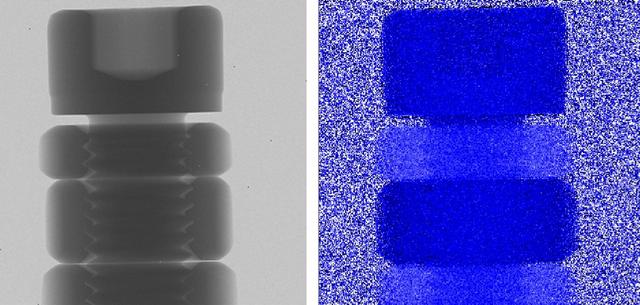Pulsed neutron sources are useful for imaging since they give different information compared with steady reactor sources [1,2]. At the pulsed neutron source, we can easily use the time-of-flight method to analyze the neutron energy and it enables us to obtain position dependent transmission data as a function of energy with high energy resolution. The transmission spectrum is affected by neutron interaction cross section, and by analyzing the energy dependency of the transmission we can deduced quantitative information of an object. ‘Quantitative evaluation’ is one of the most important characteristics of the pulsed neutron imaging.
There are various kinds of neutron interactions with matters. Coherent scattering is most important interaction to deduce the crystallographic information. We can get information on crystal phase, crystallite size, preferred orientation (texture) [3], and strain [4,5]. Micro-strain information will be included in the Bragg edge transmission [6]. Incoherent scattering does not have strong energy dependency. One of applications is to use the increase of low energy cross section of hydrogen, and the hump of cross section due to oscillation of hydrogen atom in a metal hydride [7]. Another feature of the neutron cross section is resonance peaks at higher energy. Information on dynamics of a peculiar element was studied [8], temperature was measured [9] and elemental distribution in a sample was obtained [10]. Other special feature of neutrons is magnetic interaction. By using the magnetic interaction combined with energy dependent transmission, we can evaluate the absolute value of the magnetic field [7, 11].
Material analysis and cultural heritage researches are performed by using pulsed neutron sources, and further development of data analysis is still ongoing. In the presentation, the pulsed neutron imaging method and its applications are presented.
References
[1] Y. Kiyanagi and H. Iwasa, Proceedings of the Fifth International Symposium on Advanced Nuclear Energy Research—Neutron as Microscope Probes, JAERI-M 93-228, Ibaraki, Japan, 10-12 Mar 1993, Vol.2, pp.796-801
[2] Y. Kiyanagi, T. Kamiyama, H. Iwasa and F. Hiraga, Key Engineering Materials, Vol.270-273, pp.1371-1375, (2004)
[3] H. Sato, T. Kamiyama, Y. Kiyanagi, Materials Transactions, Vol.52, No.6, pp.1294-1302, (2011)
[4] J. R. Santisteban, L. Edwards, A. Steuwer and P. J. Withers, J. Appl. Cryst. 34, (2001) 289.
[5] J. R. Santisteban, L. Edwards, M. E. Fizpatrick, A. Steuwer, P. J. Withers, Appl. Phys. A 74, (2002) S1433.
[6] T. Kamiyama, K. Iwase, H. Sato, S. Harjo, T. Ito, S. Takata, K. Aizawa, Y. Kiyanagi, Physics Procedia 88 ( 2017) 50 – 57.
[7] Y. Kiyanagi, H. Sato, T. Kamiyama and T. Shinohara, J. Physics, Conference Series 340, 012010 (2012).
[8] K. Kaneko, T. Kamiyama, Y. Kiyanagi, T. Sakuma, S. Ikeda, J. Physics and Chemistry of Solids, Vol.60, pp.1499-1502, (1999).
[9] K. Tokuda, T. Kamiyama, Y. Kiyanagi, R. Moreh and S. Ikeda, J. J. Applied Physics, vol.40, No.3A, pp.1504-1507, (2001).
[10] H. Sato, T. Kamiyama, Y. Kiyanagi, S. Ikeda, Nucl. Instr. Meth., Physics Research, A600, pp.135-138, (2009).
[11] T. Shinohara, et al., J. Physics: Conf. Series 862 (2017) 012025.
![250x200mm camera; 100kW neutron image; 120kV pulsed x-ray image[3]](http://neutronoptics.com/WCNR11/fig1.jpg)



